Iriady, Irina: Role of the AhR-Repressor and AhR-dependent CYP1 Monooxygenases in Immune Cells Regulation. - Bonn, 2024. - Dissertation, Rheinische Friedrich-Wilhelms-Universität Bonn.
Online-Ausgabe in bonndoc: https://nbn-resolving.org/urn:nbn:de:hbz:5-79627
Online-Ausgabe in bonndoc: https://nbn-resolving.org/urn:nbn:de:hbz:5-79627
@phdthesis{handle:20.500.11811/12525,
urn: https://nbn-resolving.org/urn:nbn:de:hbz:5-79627,
author = {{Irina Iriady}},
title = {Role of the AhR-Repressor and AhR-dependent CYP1 Monooxygenases in Immune Cells Regulation},
school = {Rheinische Friedrich-Wilhelms-Universität Bonn},
year = 2024,
month = nov,
note = {The Aryl hydrocarbon receptor (AhR) is a transcription factor that can be activated by various polyaromatic ligands and plays an important role in immune regulatory processes. AhR activity is regulated through the AhR-repressor (AhRR), which is involved in the regulation of immune responses according to our previous results. Apart from the AhRR, Cytochrome P450 enzymes, particularly CYP1A1, CYP1A2, and CYP1B1 also regulate AhR activity by metabolizing AhR ligands, hence curtailing the duration of AhR activation. Thus, we hypothesized that the depletion of these three CYP enzymes increases AhR’s ligand bioavailability and hence AhRR expression, affecting immune cell subsets under physiological and perturbed condition, such as Diet-Induced Obesity (DIO). To prove this, we crossed Cyp1a1-, Cyp1a2-, and Cyp1b1 (Triple CYP)-deficient mice with AhRRE/E mice that harbor an EGFP knock-in allele in the endogenous Ahrr locus (Triple CYP-KO AhRRE/E).
This dissertation demonstrated that the ablation of AhRR and the three AhR-dependent CYP enzymes enhanced AhR activation more than AhRR ablation alone, as shown by the presence of more AhRR/EGFP-expressing immune cells in various peripheral organs, such as small intestine (SI), liver, and gonadal white adipose tissue (WATg). Our previous findings showed that no AhRR/EGFP was detected in the liver of AhRRE/E mice both in immune- and nonimmune cells. However, in Triple CYP-KO AhRRE/E mice, AhRR/EGFP expression was detected not only in immune-, but also non-immune cells in the liver. Furthermore, in vivo treatment with 3- Methylcholanthrene (3MC), a potent AhR ligand, increased AhR activation and hence AhRR/EGFP expression in several immune cells of Triple CYP-KO AhRRE/E mice, particularly in liver and WATg, suggesting that AhR ligand stimulation promoted AhRR expression in an organ- and cell-specific manner. Besides, this treatment also altered the frequencies of eosinophils and adipose tissue macrophages of type 3 (ATM3) in WATg.
Due to the role of AhR signaling in immunometabolism, the physiological parameters (e.g., body weight, blood glucose, and liver enzymes), as well as the frequencies of immune cells and AhRR-expressing immune cells in the context of diet-induced obesity (DIO), were also investigated. It was shown that following 14 weeks feeding high fat diet (HFD), the ablation of AhRR ameliorated the DIO onset, as AhRRE/E and Triple CYP-KO AhRRE/E mice had reduced body- and liver-weight gain, as well as higher insulin sensitivity compared to the WT and Triple CYP-KO mice, respectively. Furthermore, HFD in combination with the ablation of AhRR and/or Triple CYP also altered both myeloid and lymphoid immune subsets mostly in liver and WATg.
Overall, the results of this dissertation highlighted the effects of dysregulated AhR signaling on the immune cell subsets not only under physiological conditions, but also in response to ligand stimulation and overnutrition.},
url = {https://hdl.handle.net/20.500.11811/12525}
}
urn: https://nbn-resolving.org/urn:nbn:de:hbz:5-79627,
author = {{Irina Iriady}},
title = {Role of the AhR-Repressor and AhR-dependent CYP1 Monooxygenases in Immune Cells Regulation},
school = {Rheinische Friedrich-Wilhelms-Universität Bonn},
year = 2024,
month = nov,
note = {The Aryl hydrocarbon receptor (AhR) is a transcription factor that can be activated by various polyaromatic ligands and plays an important role in immune regulatory processes. AhR activity is regulated through the AhR-repressor (AhRR), which is involved in the regulation of immune responses according to our previous results. Apart from the AhRR, Cytochrome P450 enzymes, particularly CYP1A1, CYP1A2, and CYP1B1 also regulate AhR activity by metabolizing AhR ligands, hence curtailing the duration of AhR activation. Thus, we hypothesized that the depletion of these three CYP enzymes increases AhR’s ligand bioavailability and hence AhRR expression, affecting immune cell subsets under physiological and perturbed condition, such as Diet-Induced Obesity (DIO). To prove this, we crossed Cyp1a1-, Cyp1a2-, and Cyp1b1 (Triple CYP)-deficient mice with AhRRE/E mice that harbor an EGFP knock-in allele in the endogenous Ahrr locus (Triple CYP-KO AhRRE/E).
This dissertation demonstrated that the ablation of AhRR and the three AhR-dependent CYP enzymes enhanced AhR activation more than AhRR ablation alone, as shown by the presence of more AhRR/EGFP-expressing immune cells in various peripheral organs, such as small intestine (SI), liver, and gonadal white adipose tissue (WATg). Our previous findings showed that no AhRR/EGFP was detected in the liver of AhRRE/E mice both in immune- and nonimmune cells. However, in Triple CYP-KO AhRRE/E mice, AhRR/EGFP expression was detected not only in immune-, but also non-immune cells in the liver. Furthermore, in vivo treatment with 3- Methylcholanthrene (3MC), a potent AhR ligand, increased AhR activation and hence AhRR/EGFP expression in several immune cells of Triple CYP-KO AhRRE/E mice, particularly in liver and WATg, suggesting that AhR ligand stimulation promoted AhRR expression in an organ- and cell-specific manner. Besides, this treatment also altered the frequencies of eosinophils and adipose tissue macrophages of type 3 (ATM3) in WATg.
Due to the role of AhR signaling in immunometabolism, the physiological parameters (e.g., body weight, blood glucose, and liver enzymes), as well as the frequencies of immune cells and AhRR-expressing immune cells in the context of diet-induced obesity (DIO), were also investigated. It was shown that following 14 weeks feeding high fat diet (HFD), the ablation of AhRR ameliorated the DIO onset, as AhRRE/E and Triple CYP-KO AhRRE/E mice had reduced body- and liver-weight gain, as well as higher insulin sensitivity compared to the WT and Triple CYP-KO mice, respectively. Furthermore, HFD in combination with the ablation of AhRR and/or Triple CYP also altered both myeloid and lymphoid immune subsets mostly in liver and WATg.
Overall, the results of this dissertation highlighted the effects of dysregulated AhR signaling on the immune cell subsets not only under physiological conditions, but also in response to ligand stimulation and overnutrition.},
url = {https://hdl.handle.net/20.500.11811/12525}
}






